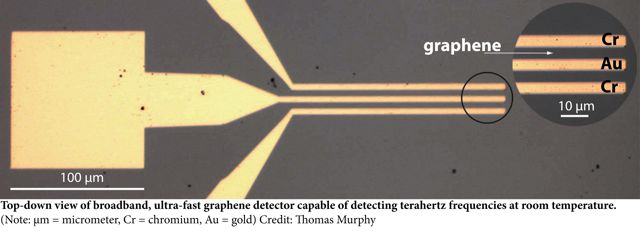
A prototype detector capable of sensing terahertz waves at room temperature has been developed by researchers from the University of Maryland (UMD) using the properties of graphene.
According to Xinghan Cai, lead author of an article describing the new detector in the Nature Nanotechnology journal, the prototype device holds potential for use in emerging terahertz fields, including chemical sensing, medical imaging, mobile communications, and night vision and security.
The discovery shows promise to develop advanced light detectors capable of viewing below the surface of walls, bodies and other objects. It is also possible to employ this highly sensitive room-temperature terahertz detector to determine chemical signatures released only in the terahertz range, which covers from microwaves to infrared waves.
Since terahertz waves are difficult to detect, most detectors are maintained at a very low temperature of -452˚F to retain the sensitivity. Existing room-temperature terahertz detectors are large, slow and high in cost. The operation of the new prototype detector is based on the “hot-electron photothermoelectric effect.” The resulting device has sensitivity similar to any existing room-temperature terahertz detectors but much faster on the order of a million times, said Michael Fuhrer, one of the researchers.
The electrons in graphene retain their energy during light absorption and do not dissipate the heat to the honeycomb lattice of the nanomaterial. As a result, the lattice stays cold, while the electrons stay hot. The electrical leads let the hot electrons out of the graphene lattice. The two electrical leads in the prototype detector are made of different metals and therefore the rate of conduction of the electrons differs.
This difference in conductivity will allow more electrons to escape through one electrical lead when compared to the other, thus generating an electrical signal. The terahertz waves present below the surface of materials that are considered as opaque to the human eye, and X-rays can be detected by this electrical signal.
Unlike X-rays, terahertz waves can visualize the zone between the skin and the bone. With high sensitivity and speed, the prototype detector paves the way to future findings in this in-between region.